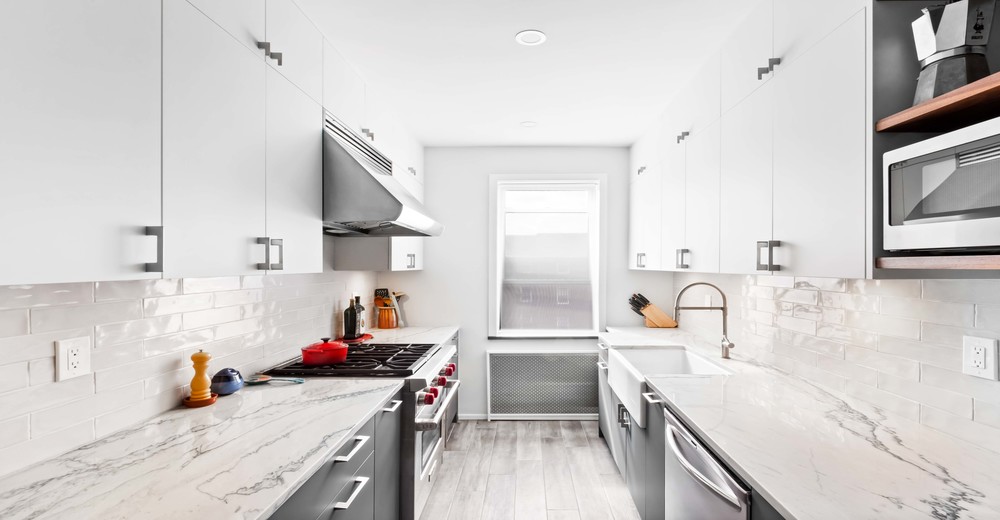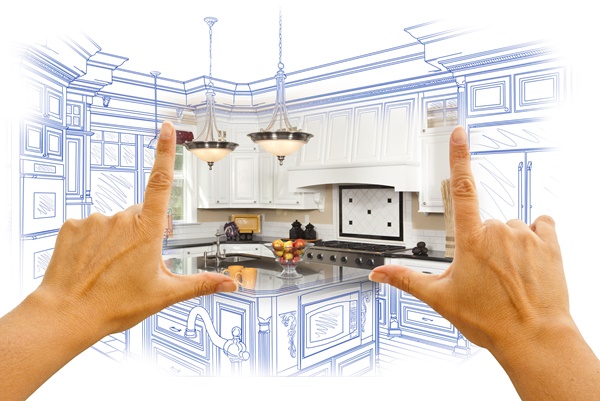How To Conduct A Smooth Small Kitchen Remodel
How to Remodel A Small Kitchen
Remodeling a small kitchen is similar to remodeling your entire home, which we outlined in detail in this article, but a few details are a little different.
Determine your budget.
First, decide on how much money you want to spend. This will help you keep tabs on your spending in the long run. Break down your budget by category: cabinets, appliances, painting, furniture, etc. This is an important first step because it prevents you from pursuing a project that is too ambitious. If you want to renovate too many areas of your small kitchen, your budget can get out of control.
Decide what you want to renovate.
Now that you have determined your budget, what do you want to renovate? Remember, always be conscious of how much room you need to move around and use your kitchen. Visualize yourself cooking in the kitchen and using it every day for all the different things you do. Also, keep your budget in mind. You can only renovate as much as it will allow.
Create a priority list.
A priority list is a great way to manage your tasks and ensure that your small kitchen renovation is done efficiently. More importantly, certain tasks need to be completed before others to ensure a smooth remodeling process.
Counters Before Sink
New counters will need to be installed before your new sink since the sink attaches to the countertop. So, to avoid any hassle, decide on a countertop material and finish that installation first.

Steps to Surviving a Kitchen Remodel
Congratulations — the kitchen remodeling job you’ve planned for months is finally ready to begin! Now comes the hard part: making do without a fully functioning kitchen for the duration. There’s no escaping the inconvenience, but with some smart planning, it doesn’t have to wreak havoc on your household. Follow these tips to make the construction process as smooth as possible.
Designate a Kitchen Stand-in
Eating out all the time gets tiresome, not to mention the strain it can put on your budget. And no matter how much takeout you bring home, you’ll still need a spot to make school lunches, pour a bowl of cereal or brew coffee. Set up a temporary kitchen somewhere that’s out of the way of construction.
Winnow Down Your Kitchen Gear
During a remodel, your cooking and eating routine will be disrupted, and no matter how much you love to cook, ambitious meals will be a challenge. Keep things simple and pare down to the kitchen tools you really, truly can’t live without. Be merciless — how often are you going to use your food processor or waffle iron? Stash the essentials close at hand and store the rest.
Plan Meals Around Small Appliances
Portable workhorses such as slow cookers, microwaves, toaster ovens, electric griddles and skillets, hot plates and coffee makers can get you over the mealtime hump.
Stock the Pantry With Disposables
Without your usual spot to wash dishes, you’ll be getting creative (the bathtub, an outdoor hose, a cooler full of sudsy water). Make life easier by stocking up on recyclable or biodegradable plates, napkins, cups and utensils. You’ll streamline cleanup and cut down on the stress of your temporary displacement.

Kitchen Remodeling
Create a kitchen remodeling plan
To achieve the dream kitchen dream kitchen that you want, first you should have a clear vision of what you want the remodel to look like.
Analyze the existing space. Take plenty of measurements with a tape measure and get a clear idea of the dimensions of your current layout.
Pros vs. cons. Decide what you like about your current kitchen’s features and what you’d like to see changed.
Set your goals. Make a list of all your kitchen remodeling goals. Include everything from simple, easy-to-accomplish tasks like organization and decorative elements to over-the-top, impossibly expensive overhauls.
Create a collection of ideas. Print out or save photos of great kitchen remodels from websites, clip photos from decorating or remodeling magazines or snap photos of kitchens you come across at the homes of friends and family, restaurants or home shows.
Prioritize your goals. Determine your top priorities. Be practical and realistic. Don’t assume that you’ll suddenly start making more regular use of your kitchen if it has pricey, stainless steel appliances.
Don’t forget remodeling takes time. A kitchen remodel will take time and likely prevent you from using your kitchen for whole days or weeks. Be sure you and your family remodel plan adequately to anticipate for periods without the use of your kitchen.
Kitchen remodel cost
One of the most important parts of any remodeling plan is deciding how much to spend. Without a clear budget, you’ll have trouble determining whether you’re making a sound investment. Come up with a firm number for the overall remodel first. If you try to make budget determinations feature by feature or appliance by appliance, you can quickly exhaust your budget.
Here are a few tips for setting a budget and making a kitchen remodel a sound investment:
Make the budget a percentage of home value. Aim to spend no more than 20 percent of the total market value of your home on your kitchen remodeling project. With this method, you should be able to come up with a reasonable budget.
Set a buffer. Take the total that you came up with and set aside 20 percent of it, or an additional 20 percent, for contingency expenses. Things do not always unfold as planned during a kitchen remodeling project, so it is smart to create a little wiggle room by setting aside some extra funds.
Have realistic expectations. Remember that you won’t see a return on your investment, if any, until the time comes to sell your home. Housing values are not static, of course, so there is no definite way to predict how much the value of your home will rise due to your kitchen remodeling work. Anything that improves the style and usability of your home is generally worth it, though, as home buyers tend to be impressed by well-designed, attractive kitchens.
Kitchen remodel features
Once you have decided on the general layout of your kitchen, you will need to make decisions about the various components that will go into it. This is where the big spending is going to happen, so you need to choose wisely.

How Much Does It Cost To Remodel A Kitchen?
Average Kitchen Remodel Cost
On average, a kitchen remodel costs $25,305 or $150 per square foot. Most homeowners spend between $13,276 and $37,550 or $75 to $250 per square foot. The total expense varies depending on the size of the space, the quality of materials, and whether you change the layout of the room.
A smaller project between $10,000 and $15,000 may include painting walls, refacing cabinets, upgrading the sink, and installing a tile backsplash. A $30,000+ renovation may include installing custom cabinets, hardwood floors, granite counters, and high-end appliances.
The kitchen serves as the heart and hearth of your home. It’s where you prepare your meals and where all your parties gather. Is it any wonder that remodeling this space is so popular and has one of the largest payoffs in terms of boosting a property’s resale value? Of course, it’s also the most complicated and can be the most expensive.
Kitchen Remodel Cost Estimator
Kitchen remodels cost $75 to $250 per square foot. The first step in determining your estimate is looking at the space. Before you get to the smaller questions, ask yourself the big questions:
What do you want from the space?
How do you want it to look and function?
Is the size and configuration right?
Also ask: What should you spend? The industry says spend 5% to 15% of the home’s value on this project. If your house is worth $300,000, you could spend $30,000 without negatively affecting its resale price.
What a Kitchen Remodel Costs — and Ways to Save
To help control costs when updating your kitchen, use the same layout, make simple style choices and do some work yourself.
The kitchen may be your home’s most popular room, but that doesn’t mean it’s the most loved. Constant foot traffic means outdated features are always visible, begging to be replaced. But can you afford it? How much you can expect to spend on your kitchen update depends on where you live, whom you hire, the materials you select and just how big a change you have planned, among other things.
What does a kitchen remodel cost?
The cost of a kitchen update can vary widely. Data from a Remodeling Magazine report puts a minor remodel in 2019 at about $22,500 and a major one around $66,200. But data from the National Kitchen and Bath Association shows remodels that involve a designer average from $48,000 to $90,000, depending on the kitchen’s size.
How to plan your kitchen remodel
Create a budget. Make a list of must-haves and want-to-haves, and work with a professional to price them. Prioritize the replacement of elements that waste money — like inefficient appliances — or that make your kitchen look dated, like stained flooring. Only when all the must-haves fit into your budget should you splurge on that warming drawer or built-in wine fridge.
Think about ROI. Keeping things simple often means more bang for your buck, especially if you’re remodeling to boost resale value. A minor kitchen remodel, which includes refinished cabinets, new flooring and a couple of updated appliances, recouped about 80.5% of the cost, according to Remodeling Magazine. A major remodel, which can include custom cabinets and all new appliances, saw about 62.1% returned in a higher home value. With that in mind, decide how much work you need done to achieve the results you want.



